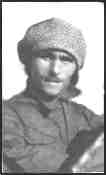
 |
| Etienne Dormoy, 1924. |
|
1885 February 10, 1885--Etienne Dormoy born in Vandoncourt (Doubs), France to Pastor Paul Amos Dormoy and his wife Antoinette Berthe Pierret. 1906 July 26, 1906--Dormoy graduated from Industrial Institute of Northern France in Lille. He earned a diploma from the Division of Civil Engineering Department (Electrical Department). Dormoy join the French Military in 1906 as an engineer. He completed his service in 1908. 1911 Dormoy became a draftsmen for the Deperdussin Company of France. The company built the world's first monocoque fuselages. Dormoy learned the art of wrapping and gluing narrow thin strips of wood around a form to make the strong airplane body without any struts so well he became an expert at it. In an interview in February, 1958, he claimed that he was the designer of the first monocoque fuselage. 1913 Dormoy met Harold D. Kantner, who went to Paris for the Aero Club of America to purchase an 18-cylinder, 160 h.p. Gnome Engine. The Deperdussin Company was to build the airframe. Kantner introduced Dormoy to Maximillian Schmiddt who hired Dormoy to move to Paterson, New Jersey to build the first true monocoque built in the United States. 1914 Kantner won the New York Times 4th of July Race in the Schmiddt monoplane with the monocoque built by Dormoy. Dormoy returned to France, joined the French Air Force and became a pilot in 1915. He was one of the first pilots to make night flights in search of zeppelins. Dormoy returned twice with his Voisin biplane riddled with bullet holes. One time five holes, another three. 1916 Dormoy flew his last mission in January. He was not released from the French Air Force at that time, but was sent back to the Deperdussin Company to help design the "Spad" fighter. 1917 With an agreement between the United States Army Signal Corps and the Deperdussin Company, Dormoy was brought back to the U.S. with two Spads and blueprints to teach the Americans how to build the Spad at the new Curtiss Elmwood Plant in Buffalo, New York. Several fuselages were made, but the complete plane was never made at the factory. This was due to the lack of the Hispano engines. The war ended leaving no use for the airplane, so the project was abandoned. 1919 Dormoy joined the Packard Motor Company. 1920 Dormoy was fired from the Packard Motor Company for drawing airplane designs instead of automobiles. He then became a civil engineer for the U.S. Army Air Force. He designed a device to spray war chemicals from an airplane. This became the forerunner for crop dusting.
Dormoy built his "Famous Flying Bathtub" airplane out of materials bought from a hardware store. The Henderson Motorcycle engine was the only thing that didn't come from the hardware store. He entered his plane in the 1924 Dayton Daily News Light Airplane Race and won. He also won the Rickenbacker Trophy and the Rickenbacker Traveling Trophy which was to go to each year's winner of the race. There was just the one race and the trophy was later given to Dormoy. (This trophy was stolen from Dormoy's San Diego home in the mid-1950's. It was 32 inches tall.)
Dormoy ended his career with the U.S. Army Air Force. He went to work for Buhl Aircraft Company. He designed all of the Buhl planes, including the Buhl Airster, a mail plane, Buhl Airsedan and the Bull Pup (test piloted by James M. Johnson). 1932 The Buhl Aircraft Company closed due to the depression. Dormoy then joined the Boeing Aircraft Company of Seattle. He was assigned to the wind tunnel division and helped design the P-26 Peashooter. 1933 Etienne Dormoy became an American citizen in Seattle, Washington on October 14, 1933. 1936 Dormoy left Boeing due to allergies induced by the damp Seattle climate. He joined the Consolidated Aircraft Company of San Diego (later renamed Convair). Consolidated sent Dormoy to Russia to oversee an American crew who was helping the Russians build a Catalina PBY. Many problems developed, including damaged parts in shipment, lack of communication and lack of cooperation by the Russians. 1938 Dormoy returned to the United States and worked for Convair until he retired. He helped Isaac Laddon design the Catalina PBY. 1958 Dormoy retired from Convair as senior design engineer. After retirement he remained active by designing a collapsible boat and a barbecue grill. 1959 On February 28, 1959, Etienne Dormoy died in a San Diego hospital of a heart ailment. This biography and illustrations were provided by Jerry M. Turner and Richard L. Meister Jr. from newspaper clippings, an interview with Phillis Dormoy (Etienne's widow) and Etienne Dormoy's records and memoirs. Jerry M. Turner and Richard L. Meister Jr are working on a book about Dormoy. The tentative title is, "Etienne Dormoy, Beyond the Flying Bathtub." Jerry M. Turner may be contacted at P.O. Box 350, Veradale, Washington 99037 © 1998 by Jerry M. Turner & Richard L. Meister, Jr. 

|